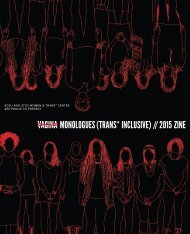You also want an ePaper? Increase the reach of your titles
YUMPU automatically turns print PDFs into web optimized ePapers that Google loves.
VOL. IV | ISSUE IV<br />
MARGINS<br />
So we’re seeing on multiple fronts, economically,<br />
they were devastated. We were also<br />
seeing already before the crisis, housing and<br />
homelessness are big issues. So that has<br />
increased precarity, but also gender-based<br />
violence. We’re seeing on multiple fronts,<br />
women experiencing incredible challenges<br />
and yet, our policy responses are not as [adequate<br />
as the] economic recovery plan came<br />
into play. Canada has never experienced<br />
something like this before, or the world with<br />
the specific gender impacts I mentioned so<br />
we can’t use a traditional approach, we need<br />
a new way of doing things. That’s what the<br />
feminist recovery plan offers – it’s a new playbook<br />
on how to deal with these types of crises.<br />
And I’ll say, for example, in previous recessions,<br />
predominantly male majority sectors<br />
are most impacted. So what is the solution?<br />
Let’s invest in more bridges, more roads, more<br />
physical infrastructure. Because who has been<br />
impacted in this crisis is different, we need to<br />
do things differently to address their unique<br />
needs and that’s what this plan offers.<br />
FA: That’s awesome. So it’s been a couple<br />
of months since the plan has been released.<br />
How do you think that the government<br />
has responded? And how have other organizations<br />
also taken in what you’ve put<br />
forward?<br />
AS: Our job is to essentially identify when<br />
government policies are not working for the<br />
people. That’s what we did with the Feminist<br />
Economic Recovery Plan, we put forward the<br />
perspectives of the people we serve through<br />
our analysis, through gendered and intersection<br />
lenses. From what we’ve seen, it has been<br />
promising, so we put up the plan at the end of<br />
July. By September, we saw the federal government<br />
commit publicly to a feminist recovery,<br />
so that was in the speech from the throne.<br />
Then we saw in the fall economic statement,<br />
money put towards an action plan on women<br />
in the economy and National Secretariat on<br />
early learning and childcare, and money for<br />
re-skilling and training programs for women<br />
who have lost their jobs because of this crisis.<br />
Those were all recommendations that were<br />
echoed in our feminist recovery plan and was<br />
really promising to see.<br />
Now, the piece of the puzzle is, we saw some<br />
investments in childcare that are promising,<br />
but we need investments in the order<br />
of billions. A couple million here and there to<br />
develop a Secretariat is important, but what<br />
we need is an actual system. We need the<br />
provinces and territories at the table because<br />
they play the central implementing role along<br />
with the municipalities. So that’s what we’re<br />
looking at for March 2021, to see significant<br />
investments to build a system that works.<br />
But we’ve seen some promising pieces –<br />
across the country we’ve also seen other levels<br />
of government and other civil societies<br />
organizations put out their plans, which was<br />
exactly what our goal was. So ours is the first<br />
nationally focused plan in the world. Since<br />
the plan was launched, we saw people in Australia<br />
look at developing their own plan, the<br />
UK and Austria have put out a plan. We’ve<br />
seen a plan come out by African feminists,<br />
we’ve seen a plan come out in South Africa.<br />
So we’re seeing this globally, this momentum<br />
for a feminist recovery.<br />
In Canada, we’ve seen feminists deliver and<br />
the province of British Columbia put out a<br />
province-wide plan and similarly in the City<br />
of Ottawa, we’ve seen a localized plan. So<br />
we’re seeing this momentum build. The goal<br />
now is to actually see that [momentum] create<br />
policy change and we’re just starting to<br />
see that.<br />
FA: I think that feeds into my next question<br />
really well, we talked about childcare and<br />
how the 2021 budget didn’t include child<br />
care work. You talked a little bit about<br />
having provinces at the table when discussing<br />
child care because they’re essential<br />
in implementing this type of policy. Do<br />
you sort of have an idea of what you see<br />
in the future regarding child care, maybe<br />
in the March 2021 federal budget?<br />
AS: Yeah, in the federal budget, we’re hoping<br />
to see billions of dollars in investments in child<br />
care. Not only does it address the realities of<br />
parents who need to work and a place for our<br />
children to go to also learn, but it’s also a job<br />
creator. Jim Stanford, at the end of December,<br />
actually put out a study looking at the fact<br />
that investments in child care, if we did it in the<br />
same model that Norway has, we would actually<br />
see potentially $29 billion in revenue per<br />
year. So in a way, investments in childcare could<br />
pay for itself. Not only that, it actually increases<br />
job creation, not only do you have to have early<br />
childhood educators, if we’re actually building<br />
more childcare centers, that’s actually jobs in<br />
construction as well.<br />
Investment in childcare creates 1.5 times more<br />
jobs compared to an equivalent investment in<br />
construction. So, you just actually get more<br />
bang for your buck, because like I was mentioning<br />
before, in previous recessions, the tool has<br />
been more infrastructure development, [which<br />
leads to] more jobs in construction. But, if you<br />
put the same money in childcare, you actually<br />
get more jobs, and you get a public service that<br />
is actually needed.<br />
FA: Going into, I guess, the last point of the<br />
recovery plan, specifically, one of the principles<br />
talked about a shadow pandemic. Could<br />
you talk a little bit about what a shadow<br />
pandemic is?<br />
AS: Yeah, so the shadow pandemic is the pandemic<br />
around gender-based violence. So I’ll<br />
be clear, gender-based violence was a significant<br />
issue well before this crisis. But unfortunately,<br />
because of the crisis, because of the<br />
nature of COVID, not only has it increased,<br />
it’s transformed gender-based violence. So<br />
what do I mean by this? So one example is<br />
more online hate. So more of us are spending<br />
time online because we have to physically<br />
be distanced. What we’re seeing is in the public<br />
realm, as especially young women, young<br />
women of colour are participating, we’re seeing<br />
gender-based violence increase in those<br />
spaces. We’re seeing gender-based violence<br />
increase in people’s homes because of that<br />
increased control that an abuser may have.<br />
We are hearing of women who are not able<br />
to access their cell phones and the internet<br />
and they’re being trapped. Also, some women<br />
have experienced threats of eviction or<br />
eviction itself, because their abusive partners<br />
are essentially saying if you retaliate,<br />
you’re going to be put on the street. So we’re<br />
seeing just devastating domestic violence.<br />
We’re also seeing people who were perhaps<br />
precariously employed or face challenges in<br />
accessing their full workplace rights are also<br />
experiencing potential challenges and gender-based<br />
violence. So I’m thinking about<br />
people who are living caregivers, who are<br />
domestic workers, who have to sometimes<br />
work in homes, during this crisis. That’s been<br />
something we’ve been keeping an eye on, the<br />
potential and the actual, increased abuse of<br />
domestic workers and living caregivers.<br />
We’re also seeing our shelters being very<br />
taxed and so in some ways, in some parts<br />
of the country, shelter use has increased<br />
because people are experiencing more violence,<br />
so they are reaching out. But we’re also<br />
worried in some communities where we’re<br />
not seeing as much engagement because<br />
people [forced into] making the decision<br />
between do I expose myself to COVID or do<br />
I expose myself to gender-based violence.<br />
[This] really speaks to that housing insecurity<br />
and affordability issue. So that is something<br />
we’re also working with public health authorities<br />
to ensure that the messaging around<br />
public health doesn’t make people feel that<br />
they can’t reach out for help. That’s also<br />
been one of the pieces of the puzzle. We’re<br />
hoping to ensure that people who need shelters<br />
[know they] are still open, shelters are<br />
still here, we are an essential service [and]<br />
we have not closed. And that’s been a huge<br />
part of the challenge around gender-based<br />
violence.<br />
16<br />
17
















